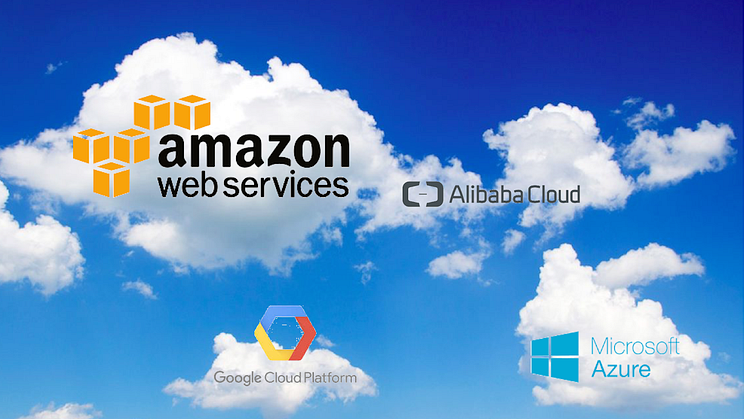
Blog post -
The Quiet Revolution – How the Giant Clouds are Taking over the Sky
The global cloud market is expected to double in size in the coming years to some $400 billion. Also in the Nordics we see fast growth of the cloud market. This quiet revolution is driven by the transformation of IT to services, the need to handle IT security and also by flexibility and innovation. The trend is manifested by the emergence of global cloud networks. In Sweden, one of the clouds services, Amazon Web Services (AWS), is expected to launch in 2018 with three new data centers. We take a look at the cloud market in this blog.
What is the cloud, really? On the surface it’s just another way to outsource your IT with the same basic technology, but it’s actually a completely new business model. To understand “the cloud”, it makes more sense to also view it as a new set of services, sold with a new price model and delivered in a new way as “IT on demand”.
With this new business model, a group of giant clouds are now fast forming global networks, led by Amazon Web Services (AWS), Microsoft Azure, Google Cloud Platform and Alibaba Cloud. We think it’s a major and quiet revolution, and we will tell you why.
The global cloud market – including public & private cloud services and legacy IT – is expected to grow from around $180 billion in 2015 to almost $400 billion in 2020. (Sources: IDC, Gartner, Forrester). The Swedish cloud market – both public and private clouds – is expected to grow from around SEK 20 billion in 2017 to almost SEK 30 billion in 2020, a healthy annual growth of almost 20%. (Source: Radar Group).
We have long talked about the cloud and cloud services, as a metaphor for IT and system resources accessed easily over the Internet. Actually the first references to cloud computing appears as early as 1996, but it was Amazon who popularized the term in 2006 with the release of its Elastic Compute Cloud (EC2) product, now a central part of Amazon Web Services (AWS). But why is the cloud market taking off now? There are four important drivers behind this growth.
1) IT is moving to operations as a service. As traditional IT is transformed to a set of services that can be purchased on demand, the functions of the traditional IT department is consequently moving to operations in a company – production, sales, marketing and finance all run their own IT services from the cloud. Most companies today, when they need for example a CRM or Business Intelligence, buy and use these functions as Software as a Service (SaaS). The driver behind this movement to IT consumed as services is not cost-savings (as were the case with the old outsourcing of hosting to a third party data center), but rather flexibility, functionality and innovation. Simultaneously, the IT cost in a company changes from capital expenditure (CapEx) to a running operational cost (OpEx). The price model changes from depreciations on investments or fixed yearly costs to an outsourcing partner, to subscriptions or hourly fees, depending on what you buy. Hosting of applications changes from manual handling of your own servers, to self-service through APIs, code and online interfaces of applications in the cloud
2) IT security drives the needs for private clouds. Another driving force is IT security. As the general digitalization of business and society increases the vulnerability of our digital systems and data, the demand for IT security is growing. Beyond the obvious market demand for security software and cyber security consultants, there is also a need for more secure hosting in local private clouds with more control. Private clouds are owned and maintained by a company or organisation, sometimes managed through a third party (a managed service provider). The private cloud might be based on hosting resources and infrastructure already present in the organisation’s on-premises data center or on new, separate cloud infrastructure. The private cloud offers more control over the organization’s data.
3) The growth of public clouds. A public cloud is an independent, third-party provider, such as Amazon Web Services (AWS), Google Cloud Platform or Microsoft Azure, that owns and manages IT resources like drives, servers, operating systems and applications that customers can access as a service over the internet. Public cloud users share these resources, and while the IT security level is naturally high, companies might still think that some of their data is too sensitive to store in a public cloud. The driving force behind using a public cloud is rather flexibility and innovation. Besides the typical “hosting” of applications and data, the public clouds also offer a wide range and fast growing menu of functions like artificial intelligence, machine learning, voice recognition and business applications that are all easily available as online services. This is really the quiet revolution – that many of the products (like a CRM or office software) is increasingly available “on tap” from the big clouds, over time disrupting traditional software markets.
4) The hybrid clouds. The majority of companies IT infrastructure is still “on the ground”, in existing on-premises legacy systems or private clouds, and will remain there for some time, while in parallel there is a need for using smart public clouds for specific reasons. This results in a need for hybrid infrastructures, or hybrid clouds. A hybrid cloud, consequently, is a model combining private clouds connecting with a public cloud infrastructure, allowing organizations to manage workloads across two different cloud environments. The public cloud then becomes an extension of the private cloud to form a single hybrid cloud. A hybrid cloud set-up requires a high level of compatibility between the underlying software and services used by both the public and private clouds.
The emergence of the global giant clouds, or the “hyperscale providers” that Gartner calls them, is a major trend. The big four AWS, Microsoft Azure, Google Cloud Platform and Alibaba Cloud are all growing fast, but AWS is in a league of it’s own with an estimated 35% market share, with Microsoft, Google and Alibaba catching up behind with some way to go.

Notably, there is no big cloud in Europe competing with the giants in the USA and China. And it is not very likely that any major European hyperscale cloud is going to emerge in this market, it is already too competitive and the existing hyperscale clouds are already too big. So Nordic and European companies and organisations will have to decide whether they want their data in an American och Chinese cloud, and probably in combination with their local private clouds. There is now a great menu of smart functionality building up in the major clouds and many companies are starting to look at how they can combine there functions to be more competitive.
Even though Microsoft as a software supplier is dominant in the Nordic region, it is still likely that many Nordic companies and organizations will turn to AWS (which have been established in Sweden since 2011) as Amazon is now building three big data centers in Sweden around Stockholm, launching in 2018. We also expect AWS to open more data centers across the Nordics in the coming years. This in turn will probably set the foundation for an interesting Nordic market and local ecosystem of cloud consultants and specialists, managed service providers, SaaS developers and complementing local private clouds.
We also see a wide range of sectors adopting cloud services. Many banks and financial institutions, for example, are already migrating to the cloud, with as many as 97% of CIOs (according to one study) anticipating some form of cloud adoption by end of the year. A huge number that suggests an overwhelming acceptance of the technology or at least, a private-public hybrid solution.
The emergence of the global cloud networks is similar to the last time when Silicon Valley established a new business model that quickly came to dominate a whole industry: online advertising. Google launched its global digital ad infrastructure, AdWords, based on a new online service, simplicity, effectiveness and price model. It quickly became one of the most successful business models in history. Today Google and Facebook, who became two of the world’s most valuable and powerful companies thanks to their global digital infrastructures, together control close to 70% of global online advertising. In the process, a new industry of data-driven online marketing specialists, e-commerce companies and product developers emerged that forever changed the advertising business. The same is now happening with the traditional IT infrastructure industry. The cloud market is a quiet revolution in the making.

